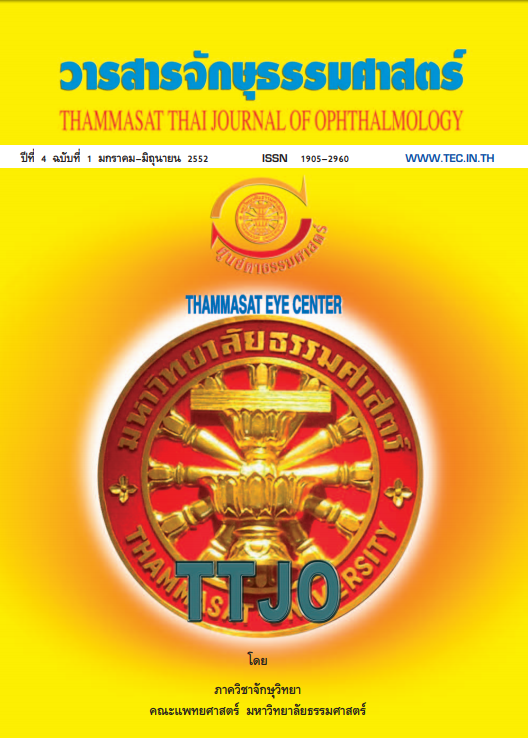The Use of the Non-Mydriatic Fundus Camera in Glaucoma Evaluation
Main Article Content
Abstract
Objective: To evaluate the use of the non-mydriatic fundus camera in evaluation of optic nerve head vertical cup to disc ratio in glaucoma patients.
Design: Cross-sectional descriptive comparative study
Material and Method: Indirect ophthalmoscopy with 78 diopter lens and a digital non-mydriatic fundus camera were performed in forty two subjects (23 normal controls and 19 glaucoma). The estimated vertical cup to disc ratio (VCDR) from both methods were analyzed. The effect of the pupillary dilation on the estimation of VCDR from non-mydriatic fundus camera was also determined.
Result: The mean ophthalmoscopically estimated VCDR was (mean ± SD) 0.479 ± 0.18, compared with a VCDR of (mean ± SD) 0.462 ± 0.18, measured with the non-mydriatic fundus camera (difference 0.017; 95% confidence interval [CI], 0.005-0.028; p=0.007). The overall correlation between the non-mydriatic fundus camera and indirect ophthalmoscopy with 78 D lens is 0.895 (p<0.001). From the receiver operating curve (ROC) at 90% specificity, the estimated VCDR from the non-mydriatic fundus camera yielded 68.4% sensitivity.
Conclusion: The non-mydriatic fundus camera provided good correlation with minimal difference in the estimated VCDR, when compared with the standard indirect ophthalmoscopy with a 78 D lens. In conjunction with IOP measurement, a non-mydriatic fundus camera can make a useful tool for glaucoma screening.
การวิจัยเรื่องความแม่นยำในการใช้ Non Mydriatic Fundus Camera ในการประเมินขนาดของขั่วประสาทตาสำหรับประเมินผู้ป่วยโรคต้อหิน
วัตถุประสงค์: เพื่อศึกษาถึงประสิทธิภาพในการใช้ Non mydriatic fundaus camera ในการประเมินขนาดของขั้วประสาทตาว่ามีความแม่นยำ มากน้อยเพียงใด เมื่อเทียบกับการประเมินขั้วประสาทตาด้วยวิธีมาตรฐานที่ดูด้วยกล้องตรวจตา slit lamp ร่วมกับ indirect lens (78 D)
ลักษณะการวิจัย: Cross-sectional descriptive comparative study
วิธีการวิจัย: ทำการศึกษาในกลุ่มคนไข้จำนวน 42 คน โดยทำการเปรียบเทียบในกลุ่มทีได้รับการวิจัยฉัยว่าเป็นต้อหินจำนวน 19 คน กับกลุ่มควบคุมที่เข้ามา รับการตรวจตาด้วยโรคอื่นๆ จำนวน 23 คน โดยทั้งสองกลุ่มจะได้รับการวัดขนาดของขั้วประสาทจากการประเมินรูปถ่ายขั้ว ประสาทตาที่ถ่ายด้วยกล้อง Non mydriatic fundus camera เทียบกับวิธีมาตรฐานโดยการดูด้วย slit lamp คู่กับ indirect lens (78 D) ขนาดความกว้างของขั้วประสาทตาในแนวดิ่ง (vertical cup to disc ratio; VCDR) ที่ได้จากการตรวจทั้งสองแบบจะถูกนำมาเปรียบเทียบกัน นอกจากนั้นจะดูผลของการใช้ยาขยายม่านตาที่มีต่อขนาดของขั้วประสาทตาที่ ประเมินได้จากการวัดด้วยวิธีทั้ง 2 อย่างร่วมด้วย
ผลการวิจัย: ค่าเฉลี่ยของ VCDR ที่วัดได้จาก indirect lens (78D) มีค่า (mean +- SD) 0.479 +- 0.18, เมื่อเทียบกับ VCDR ที่วัดได้จากการประมาณขนาดของขั้วประสาทตาที่ได้จากภาพถ่ายจาก Non mydriatic fundus camera (0.462 +-0.18) (ค่าความแตกต่างเฉลี่ย 0.017; 95% confidence interval [CI], 0.005-0.028; p=0.007) ความสัมพันธ์ของค่าที่วัดได้จากเครื่องมือทั้งสองชนิด(correlation) ของเครื่อง Non mydriatic fundus camera ในการคัดกรองโรคต้อหินอยู่ในระดับปานกลางที่ประมาณ 68.4%
สรุปผลการวิจัย: การประเมินขนาดของขั้วประสาทด้วยเครื่อง Non mydriatic fundus camera นั้นเป็นวิธีการที่ไม่ต้องอาศัยการหยอดยาขยายม่านตา และให้ผลใกล้เคียงกับวิธีวัดขนาดแบบมาตรฐานด้วยการดูด้วย indirect lens (78D) ซึ่งเมื่อใช้ร่วมกับการวัดความดันลูกตาแล้ว เครื่องมือนี้จะช่วยอำนวยความสะดวก และเป็นประโยชน์อย่างมากสำหรับการประเมินขั้วประสาทตาสำหรับการคัดกรองต้อ หินในผู้ป่วยที่มาตรวจตาด้วยโรคทั่วไปได้เป็นอย่างดี
Article Details
References
Ryder RE, Vora JP, Atiea JA, Owens DR, Hayes TM, and Young S. çPossible New Method to Improve Detection of Diabetic Retinopathy: Polaroid Non-mydriatic Retinal Photographyé. Br Med J (Clin Res Ed). 1985 Nov 2; 291(6504):1256-1257.
Phiri R, Keeffe JE, Harper CA, and Taylor HR. çComparative Study of the Polaroid and Digital Non-mydriatic Cameras in the Detection of Referrable Diabetic Retinopathy in Australiaé. Diabet Med. 2006 Aug;23(8):867- 72.
Muller A, Vu HT, Ferraro JG, Keeffe JE, and Taylor HR. çRapid and Cost-effective Method to Assess Vision Disorders in a Populationé. Clin Experiment Ophthalmol. 2006 Aug; 34(6):521-5.
Hansen AB, Hartvig NV, Jensen MS, Borch-Johnsen K, Lund-Andersen H, and Larsen M. çDiabetic Retinopathy Screening Using Digital Non-mydriatic Fundus Photography and Automated Image Analysisé. Acta Ophthalmol Scand. 2004 Dec;82(6):666-72.
Massin P, Erginay A, Ben Mehidi A, Vicaut E, Quentel G, Victor Z, Marre M, Guillausseau PJ, Gaudric A. Evaluation of a new nonmydriatic digital camera for detection of diabetic retinopathy. Diabet Med. 2003 Aug;20(8):635-41.
Garway-Heath DF, Ruben ST, Viswanathan A, Hitchings RA. Vertical cup/disc ratio in relation to optic disc size: its value in the assessment of the glaucoma suspect. Br J Ophthalmol 1998;82:1118-24.
Jonas JB, Budde WM, Panda-Jonas S. Ophthalmoscopic evaluation of the optic nerve head. Surv Ophthalmol 1999;43:293-320.
Wolfs RC, Ramrattan RS, Hofman A, de Jong PT. Cup-to-disc ratio: ophthalmoscopy versus automated measurement in a general population: The Rotterdam Study. Ophthalmology. 1999 Aug;106(8):1597-601.
Lichter PR. Variability of expert observers in evaluating the optic disc. Trans Am Ophthalmol Soc. 1976;74:532-72.
Varma R, Steinmann WC, Scott IU. Expert agreement in evaluating the optic disc for glaucoma. Ophthalmology 1992;99:215-221
Tuulonen A, Airaksinen PJ, Montagna A, Nieminen H. Screening for glaucoma with a non-mydriatic fundus camera. Acta Ophthalmol (Copenh). 1990 Aug;68(4):445-9.
Detry-Morel M, Zeyen T, Kestelyn P, Collignon J, Goethals M; Belgian Glaucoma Society. Screening for glaucoma in a general population with the non-mydriatic fundus camera and the frequency doubling perimeter. Eur J Ophthalmol. 2004 Sep-Oct;14(5):387-93.
Quigley MG, Dube P. A new fundus camera technique to help calculate eye-camera magnification: a rapid means to measure disc size. Arch Ophthalmol. 2003 May;121(5):707-9.
Taylor DJ, Fisher J, Jacob J, Tooke JE. The use of digital cameras in a mobile retinal screening environment. Diabet Med. 1999 Aug;16(8):680-6.


